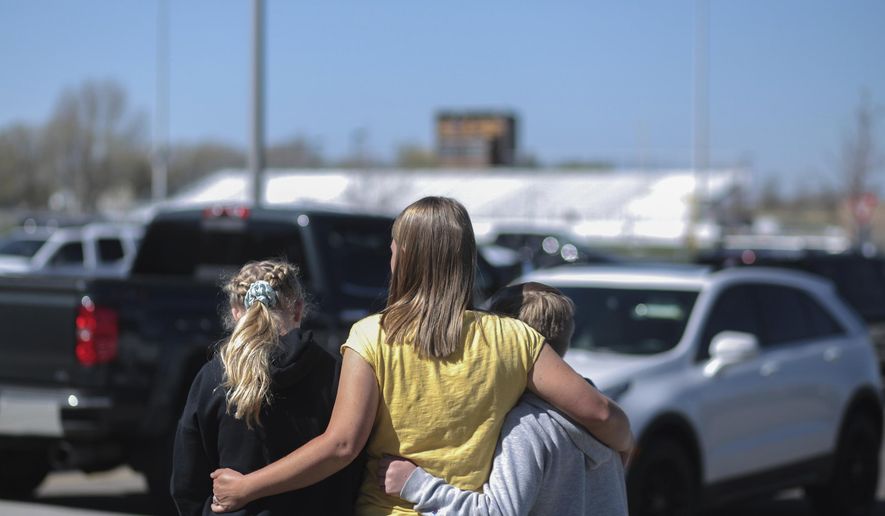BOISE, Idaho (AP) - Authorities say they are trying to determine what prompted a young girl to open fire at a rural Idaho middle school, one of the few school shootings in which the suspect is female.
The shooting happened around 9 a.m. Thursday, when police say the girl pulled a handgun out of her backpack and shot two other students and an adult custodian before she was disarmed by a teacher and held until police arrived. All three were shot in the extremities, and none had life-threatening injuries.
Jefferson County Sheriff Steve Anderson said Friday the investigation is likely to take a “considerable amount of time.” He said neither the name of the suspect - a sixth-grade girl - nor the name of the teacher who disarmed her would be immediately released.
The shooting took place over the course of about five minutes, Anderson said.
School shootings are rare in Idaho, and shootings where the suspect is identified as a young girl are uncommon but not unheard of nationwide.
Girls and women commit just 2% of both mass shootings and school shootings in the U.S., according to data compiled by the group The Violence Project.
The group maintains a database of shootings at schools where more than one person was shot or a person came to school heavily armed with the intention of firing indiscriminately. It includes 146 cases going back to 1980. Girls were the shooters in just three of those cases. Experts differ on exactly why, though it’s known that men commit over 90% homicides in general.
Researchers have also found that shooters who target bigger groups or schools tend to study past perpetrators, who are more likely to be male.
“They see themselves in some of these other shooters,” said Violence Project President Jillian Peterson, a forensic psychologist and professor at Hamline University in Minnesota.
Boys in general tend to externalize anger and sadness against other people, whereas girls are more likely to internalize those emotions and have higher rates of depression and anxiety, Peterson said.
The Idaho girl is also younger than most school shooters, who are more often in high school.
The Violence Project’s database shows about 18% of school shootings were at middle schools, though most of those were among older teenagers. Only a handful involved sixth-grade students, Peterson said.
Two recent studies by the U.S. Secret Service’s National Threat Assessment Center offer insight into common characteristics between many kids who plan or carry out school shootings. The students were often badly bullied, suffered from depression with stress at home and exhibited behavior that worried others. They were often absent from school before the attack.
Most attackers who carried out deadly school shootings were male; seven were female, according to the studies. Researchers said 63% of the attackers were white, 15% were Black, 5% Hispanic, 2% were American Indian or Alaska Native, 10% were of two or more races, and 5% were undetermined.
School shootings have become increasingly common in the U.S. over the past two decades, but they remain relatively rare in Idaho. In 1999, a student at a high school in the community of Notus, west of Boise, fired a shotgun several times. No one was struck by the gunfire, but one student was injured by ricocheting debris from the first shell.
In 1989, a student at Rigby Junior High pulled a gun, threatened a teacher and students, and took a 14-year-old girl hostage. Police safely rescued the hostage from a nearby church about an hour later and took the teen into custody. No one was shot in that incident.
In 2016, Idaho lawmakers passed a bill that allowed most people to carry concealed weapons without a permit. But that right doesn’t extend to schools, courthouses or correctional facilities.
Earlier this year, Rep. Chad Christensen, a Republican from Ammon - just 15 miles (24 kilometers) south of Rigby - pushed for legislation that would allow school district employees with enhanced concealed weapons permits to carry guns on school property. The bill passed the House but didn’t move forward in a Senate committee. Similar legislation was rejected in 2019 and 2020.
In a Facebook post made roughly two hours after the Rigby Middle School shooting, Christensen said the state needed to do more to stop shootings, and he criticized those who pushed against his concealed weapons bill.
“For all of those that have stood in the way of my school carry bill, shame on you. You know who you are!” Christensen wrote.
The Idaho chapters of Moms Demand Action and Students Demand Action - both part of Everytown for Gun Safety, a gun control advocacy group - said forcing more guns into schools isn’t the solution.
“The idea that we should be bringing more guns into our schools after what happened today is ridiculous,” Idaho Moms Demand Action volunteer Theresa Kaufmann said in a prepared statement on Thursday. “We need our lawmakers to stop putting children, teachers and the entire state in danger by weakening our already weak gun laws.”
___
Associated Press writer Colleen Long in Washington contributed to this report. Whitehurst reported from Salt Lake City.




Please read our comment policy before commenting.